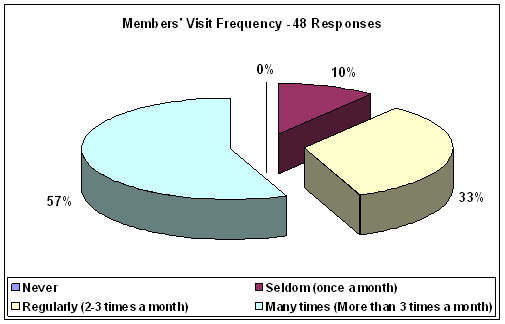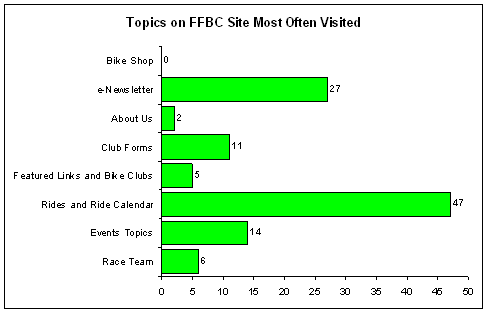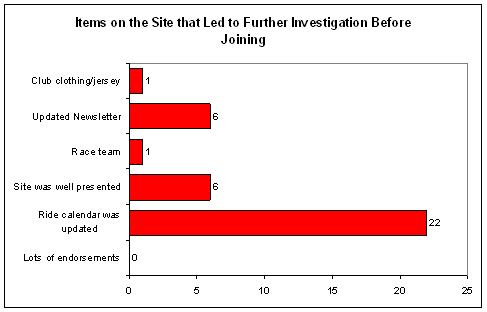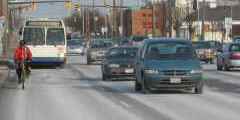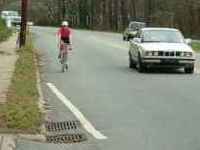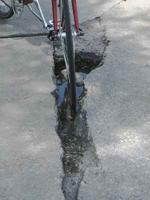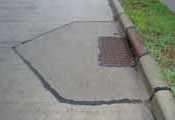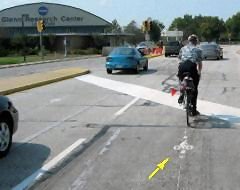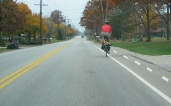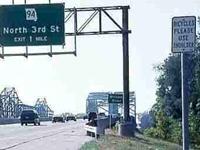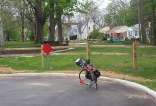
|
SPECIAL HAPPENINGS In preparation to consider changes to the FFBC Website, a survey was distributed to the members to obtain some member usage data and other member characteristics. Below are the results of the survey. Plans are afoot (albeit in hibernation during the holidays) to find ways to “enhance” and “refresh” the look of the site, but at minimal cost and without adding technical complexities to the management. The results of this survey will provide guidelines on how to rearrange the content of the website to address needs of existing and prospective members. Members Survey Results
Bicycle Blunders and Smarter Solutions (continuing article submitted by Wynn Kageyama)by Fred Oswald, LCI #947 9. Smarter Solutions -- Appropriate Facilities & Best Practices
Training Engineers, Planners, OfficialsEarlier, we asked rhetorically: "How would you like to drive a car on a road designed by an engineer who does not know how to drive and does not understand the rules of the road?" Those who plan and design bicycle facilities out of ignorance because they do not know how to operate a bicycle as a vehicle and thus create hazards are committing malpractice. To avoid the risk of malpractice, get some training [1]. (As an interim measure, at least employ consultants with significant and relevant experience.) Simply attending a good seminar on vehicular cycling is not enough, although it certainly helps. The planner or engineer must thoroughly understand why bicycles must be operated as vehicles in order to resist pressure for ill-advised facilities from misinformed "bicycle advocates". How can you tell if someone, including yourself, is a competent bicycle driver? A quick indicator is the ability to make a left turn in heavy traffic by "negotiating" with other drivers. (See photo "Left merge in traffic" in section 7 of this article.) Benign Neglect
The picture at right shows a very good road for cycling. It has multiple lanes (5) that allow faster traffic to pass easily. The surface is in good condition and it is thoroughly salted in winter. Sewer drains are in the curb face, so they pose no hazard. The vehicle detectors at traffic lights are not marked but they work for any cyclist who knows where to stop. Most buses (but not the one pictured) carry bike racks, handy in case of bad weather or mechanical problems. This writer has no doubt that bicycle traffic was not considered when the road was built or recently re-paved. Indeed, the city engineer did not know, until this author told him, that the vehicle detectors work for bicycles. This is a good example of benign neglect -- a well maintained road that is perfectly suited for bicycle transportation.
How might the road above be improved? Marking the vehicle detectors would help. If money were no object, another 2-3 feet of space in the right lane would be useful when traffic is heavy. But most of the time, traffic is not heavy so extra width would be wasteful. The greatest room for improvement is in education: Teaching cyclists, motorists and police that bicycles are vehicles that should be operated on the same road, by the same rules and with the same rights as other vehicles. Be sure to teach cyclists the "secret" of proper lane position so they are safer and more comfortable on the road. And teach motorists that cyclists belong on the road, not on the sidewalk. Where space permits and traffic volumes justify the expense, a wide curb lane, as is shown in the photo at right, benefits all users of the roads. A wide lane helps motorists pass safely without delay. The extra space also helps cyclists feel more at home on the road. Wide curb lanes and with smooth pavement should be the preferred means of "accommodating" bicycle traffic. Wide lanes do not cause the safety hazards that separate facilities do. Where the curb lane is not wide enough for sharing between a bicycle and a motor vehicle, the cyclist must be expected and encouraged to use the full lane. In the photo, notice how the passing motorist is allowing generous clearance, yet not encroaching in the oncoming traffic lane. Also note the marking for an obstruction: a paint stripe that warns a cyclist away from a drain grate in the roadway. This is good practice consistent with guidelines in the Manual of Uniform Traffic Control Devices.
Not-So-Benign NeglectNeglecting to fix road hazards exposes cyclists to danger. Public officials, highway engineers, road maintenance supervisors, and others concerned with building and maintaining roadways must understand that bicycles are balanced vehicles, often with hard, narrow tires and without a soft suspension. This makes cyclists highly vulnerable to road surface defects, such as bumps, holes, ridges and slots. The defect shown in the top photo at right is a deep slot at the joint between concrete of the roadway and a separate pour around a drain grate. Such defects are common on old concrete roads. This one may have been big enough to bring down a motorcycle. This author took a one-page list of road hazards with photos and explanations of the dangers involved to a city council meeting. By the next day, most of the defects had been temporarily patched. Note the safer drain grate seam below right. When a city is informed of defects such as at right, it must promptly fix the problem or be liable for any injuries caused. If not informed, officials may claim ignorance of the defect as a legal defense. It is better if the city welcomes the reporting of defects by making it easy via a web site report form or a telephone "hotline". The best cities train their road maintenance supervisors and other officials so they recognize, understand and when possible, prevent these problems. The second photo at right shows a safer seam around a drain grate. This design avoids a slot in the direction of travel, making it less likely to trap a wheel and cause a fall.
Vehicle DetectorsAnother example of not-so-benign neglect is vehicle detector loops that fail to detect bicycles. Some traffic officials deliberately ignore this problem because they do not want to encourage cyclists to be on the road. If vehicle detectors do not work for cyclists, the community loses some of its moral right to enforce traffic law. Communities can help cyclists and encourage respect for traffic law by marking vehicle detector loops to show where to stop the bicycle in order to trigger the circuit. NASA Glenn Research Center has done just that as part of its effort for the Cyclist Friendly Communities Award. The photo at right shows the traffic light by the Main Entrance. Note the small stencil over the cut mark in the middle of both traffic lanes. Roadway ShouldersShoulders are a popular place for touring cyclists riding in the country. Riding on the shoulder is appropriate for one who is cycling along a freeway. But on an urban road, the shoulder is often NOT a safe place to ride. A shoulder cyclist is much more likely to suffer a collision with turning traffic because other drivers do not look for conflicting traffic off the roadway. In addition, the shoulder is likely to accumulate glass, gravel and other debris because passing traffic does not "sweep" it clean. In some states, operating a vehicle (including a bicycle) on the shoulder is technically illegal. This could cause a serious legal problem in the event of a crash. This is why knowledgeable cyclists avoid shoulders on urban roads.
A small shoulder protects the edge of the pavement from being broken by keeping heavy wheels nearer the middle of the road where the road is better supported. A two foot shoulder is usually enough for this benefit. In the photo at right, the travel lane is of marginal width to allow faster traffic to pass a bicycle. The four feet of pavement in the shoulder is largely wasted as far as cycling is concerned. If the fog line were moved over as indicated by the dashed line, then the lane would be wide enough to share with faster traffic. The remaining shoulder would still protect the edge of the pavement. Access to Bridges and Freeway Shoulders
In many U.S. states (particularly in the West) cyclists are permitted access to the shoulder of freeways in rural areas or where a reasonable alternate route is not available. In the photo at right (Highway 370 in MO, crossing Missouri River), the sign at far right tells cyclists to ride on the shoulder. The safety record for such access is quite good because, except at interchanges, there is no turning or crossing traffic to produce a hazard. Even in cities, there are places where cyclists should be allowed freeway shoulder access to cross an obstruction, such as a river, by entering just before the bridge and exiting just after. In some cases, a freeway replaced an older route that once provided cyclist access. Moreover, a new, cyclist-prohibited freeway bridge is likely to be safer than the old, cyclist-permitted bridge. In some states, traffic laws must be corrected to permit freeway shoulder access. Where Separate Facilities May be Appropriate
Separate bicycle facilities are helpful in some situations: (1) As shortcuts or supplements to the road system to improve connectivity. Examples include connecting "suburban sprawl" neighborhoods, through parks or other places where cars are not welcome or to bypass a "traffic calming" barricade. The photo at right shows a cul-de-sac where a short path would be useful. (2) For recreational trails. (However be careful at road crossings). (3) On long-narrow bridges where on-road access would otherwise not be feasible (However, beware the approaches and avoid 2-way paths) . In a very few places, bike lanes may actually improve conditions for cyclists. John Allen gives an example on the Charles River Road near Boston. However, generally a bike lane provides more illusion of safety than reality. Alternatives to Separate Facilities
In previous sections, we have shown that separate bicycle facilities often introduce hazards because they discourage following of the rules of the road. In addition, many of these facilities have dangerous design defects. A correctly designed, properly constructed and well maintained road is almost always the best bicycle facility. Where bicycle facilities must be installed because of political pressure from the uninformed consider "stripeless" bike lanes instead of traditional bike lanes. These consist of a bike stencil with arrow (sometimes called a "Sharrow") or similar marking, (another style is a "chevron") with no extra lane stripes. Be aware that a pair of bike lane stripes is a traffic control device that tells people where to ride. As we have seen in an earlier part of this series, bike lane stripes often tell cyclists to ride in an unsafe place.
Making bike lanes stripeless avoids most of the problems of a marked bike lane, so long as the stencils are placed correctly. This is likely to be a problem on streets where parking is allowed. The symbols must never be placed closer than five feet from parked cars (this means at least thirteen feet from the curb, 14-15 feet is better). The best place for these stencils is near the middle of the traffic lane (between the wheel tracks) where they also last longer. In most cases, the best bicycle facilities are well-designed ordinary roads. Most important of all, we must understand that facilities are never a substitute for education. We must fund education first. Footnotes[1] A good place to start is to seek advice (go for a training ride) from a Certified League Cycling Instructor. Consider taking a BikeEd Road I course yourself. Unfortunately, due to a breakdown in the training program in 2001-2003 a few BikeEd instructors are not fully qualified. Be sure any you deal with are consistent with the principles of Effective Cycling. Please join us and help restore the BikeLeague to members.See www.labreform.org to join LAB Reform. |
